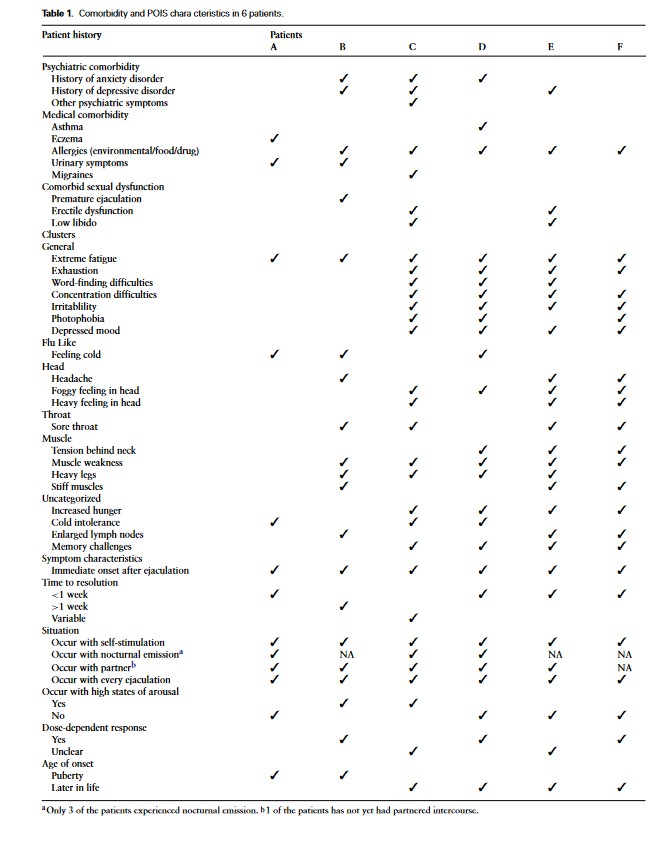POIS-Diagnosis
There are still no meaningful biomarkers for POIS. This makes diagnosis extremely difficult. In many affected men, for example, hormone and inflammation levels before and after ejaculation are within the normal range. Men suffering from POIS are therefore often not taken seriously by the urologist treating them or are referred to a therapist. As a result, it can take years for sufferers to get medical help.
The Dutch sexologist Marcel D. Waldinger first drew attention to POIS in a study from 2002.1 This was followed in 2011 by the first large-scale POIS study on 45 Dutch men.2 In it, Waldinger defined five diagnostic criteria for recognizing POIS.
Diagnostic criteria
1. symptoms: flu, fatigue, brain fog, depression
One or more of the following symptoms occur: Feeling of a flu-like state, extreme tiredness and fatigue, weak muscles, fever and heavy sweating, mood swings and easy irritability, memory difficulties, concentration problems, incoherent speech, stuffy or runny nose, burning eyes.
2. onset: Immediately
All symptoms occur within a few seconds, after a few minutes or within a few hours after ejaculation triggered by sexual intercourse, masturbation or spontaneously (e.g. nocturnal ejaculation).
3. frequency: almost always
Symptoms always or almost always occur, i.e. after 90% or more of all ejaculations.
4. duration: 2-7 days
Die meisten Symptome dauern circa zwei bis sieben Tage.
5. recovery: rapid recovery
Symptoms disappear spontaneously.
Expansion of the diagnostic markers to include
non-flu-like and psychological symptoms
Based on these criteria, Rosetti et al.3 were able to add numerous non-flu-like symptoms to the diagnostic markers in a study of six men. They also found evidence of the development of symptoms solely due to sexual arousal and identified comorbidity (the co-occurrence of several illnesses) with environmental allergies and psychiatric illnesses such as depression and anxiety disorders in the majority of patients. In contrast, they found no evidence of an allergic reaction in the blood values.
The following table provides an overview of the diagnostic markers and comorbidities identified by Rosetti et al. in six patients:

Three out of six patients had a history of depression or anxiety. Four patients suffered from environmental allergies, which is consistent with the results of other studies. No patient reported similar symptoms in the family. In all patients, symptoms occurred immediately after any ejaculation, be it nocturnal ejaculation or sexual stimulation by self or partner. In two men in the sample, the symptoms lasted longer than seven days.
The most common symptom clusters in the patient group were head, general and muscle symptoms, which, according to the authors, was consistent with findings in larger samples. All patients reported extreme fatigue after ejaculation, and five out of six reported muscle weakness. Three out of six described symptoms not mentioned in previous studies such as increased hunger, cold intolerance, enlarged lymph nodes and memory impairment.
Moving on to POIS treatment
- Waldinger, M. D., & Schweitzer, D. H. (2002). Postorgasmic Illness Syndrome: Two Cases. Journal of Sex & Marital Therapy, 28(3), 251–255. ↩︎
- Marcel D. Waldinger, Marcus M.H.M. Meinardi, Aeilko H. Zwinderman, Dave H. Schweitzer, Postorgasmic Illness Syndrome (POIS) in 45 Dutch Caucasian Males: Clinical Characteristics and Evidence for an Immunogenic Pathogenesis (Part 1), The Journal of Sexual Medicine, Volume 8, Issue 4, April 2011, Pages 1164–1170. ↩︎
- Leah Rosetti, Amin Kanani, Luke Witherspoon, Ryan Flannigan, Stacy Elliott, Case series: expanding diagnostic markers in postorgasmic illness syndrome, Sexual Medicine, Volume 11, Issue 2, April 2023, qfac021 ↩︎
- Ibid. ↩︎